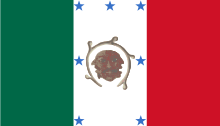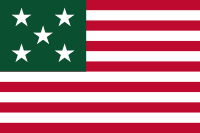Flag of Aztlán

The flag of Aztlán is an unofficial flag used by Chicano nationalists in the late 1960s and early 1970s.

According to Salvador Roberto Torres, an early Chicano activist and artist and one of the founders of the Centro Cultural de la Raza and Chicano Park, "The symbol of the three face image, the Spanish (European), the Native, and ... the Mestizo, the child of both. Emanuel Martinez of Denver Colorado first brought this image to our Chicano Movement as seen in 1969 at the Denver, Colorado, Crusade for Justice, led by Rodolfo Gonzales. Non-commissioned, Salvador Torres recalls the first flag designed and made by Guillermo Aranda, second flag by the San Diego Brown Berets, third flag by Gloria and Salvador Torres. Gloria and Salvador Torres' flag of Aztlan has seven stars, California, Arizona, Colorado, New Mexico and Texas; and parts of Montana, Utah, Oregon, Nevada, Kansas and Wyoming. The entire landmass of what's the Western United States are also considered part of 'The Creation of a Spiritual Nation') see Codex Tamuanchan: On Becoming Human, by Roberto Rodriguez, 1998. The concept of 'El Plan de Aztlan' of 1969, as proclaimed at the Denver Colorado, Chicano Youth Conference, at the Crusade for Justice, and announced at the Chicano Moratorium of the Vietnam War, Los Angeles, California. 1970 was answered with a major riot and the death of Rubén Salazar, death and injury to many others August 29, 1970. See Chicano history and film Requiem 29. Roberto Rodriguez makes divine our freedom 'to view ourselves as sovereign is uplifting and liberating and is even beyond the concepts of decolonization and self determination. It is the antithesis of being conquered, colonized, and oppressed.'"
However, according to Emanuel Martinez, "I did not create the flag of Aztlan that you are referring to. It was created by Yermo Vasquez, formerly known as Bill Longley who married Henrieta Vasquez and changed his name. He was my mentor as a teenager. I did, however, inspire him to do it after I created the new Mestizo head. Yermo is deceased now."
While the flag exists in several versions, its essence has remained the same. It is composed of three rectangular fields of green, white, and red, like the Mexican flag. However, in the center field, instead of the Mexican national seal is a three-faced symbol of mestizaje. The mestizaje of the face is dual, in that it represents both the racial mixing of Mexico's European and indigenous heritages, as well as the cultural mixing of Mexican and American cultures as experienced by Chicanos.
The flag was raised on an old lightpole on April 22, 1970, the day of the takeover of Chicano Park. Since then, Torres and his wife Gloria have continued to raise the flag over Chicano Park, both at the annual celebration of Chicano Park Day and for field trips to Chicano Park coordinated through their 'Young at Art' program.
References
- ^ Torres, Salvador, quoted in the Catalogue of Slides from the Salvador Roberto Torres Papers, housed at the California Ethnic and Multicultural Archives, UC Santa Barbara. The description is of the slide identified as Cat.13 050 (1).